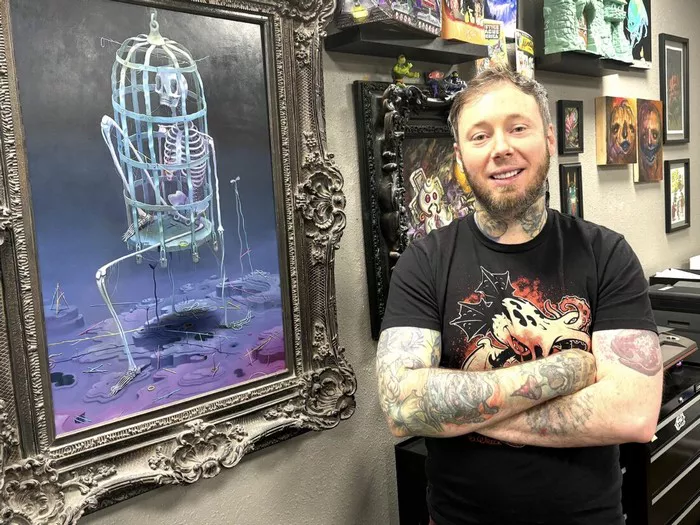Jordan Ross, a local tattoo artist, has been in the tattooing profession since 2004, accumulating nearly two decades of experience witnessing the evolution within the industry.
Tattooing involves applying micro pigment particles into the skin’s dermis, a process that has evolved from ancient methods using bone, tooth, and plant pigments to modern electric tattoo needle bars, cartridges, and medical-grade sterile ink.
According to Ross, being a competent tattoo artist requires two main skills. Firstly, the ability to create artwork, and secondly, proficiency in the technical application of sterile tattooing procedures. Mastering both aspects is crucial for producing high-quality, long-lasting tattoos.
Ross prepares for appointments by meticulously creating designs in advance. He conducts thorough research to ensure that any traditional meanings associated with the tattoo images do not pose issues.
“Tattoo artists may not know the full history behind every image, so research is crucial to avoid mistakes and ensure a well-executed tattoo,” Ross emphasized.
Initially sketching all designs on a tablet, Ross then transfers them onto the skin using acetate carbon stencils. He adjusts the designs directly on the skin to complement the body’s contours. Often, clients bring in images sourced from the internet for what he terms “print and play” tattoos—simple designs quickly etched into the skin.
When Ross first entered the field, tattooing regulations were vague until health departments began to intervene. He observed a shift towards higher standards of procedural sterility, especially in smaller communities catching up with industry norms.
“The industry has progressed from basic, informal applications to highly scrutinized artistic creations demanded by knowledgeable clients,” Ross noted.
Traditionally, tattooing skills were passed down from master to apprentice, but now, with widespread access to online and televised education, the industry has seen significant advancements.
“Today, some clients may actually be more informed than tattoo artists were two decades ago,” Ross remarked.
Recently, artificial intelligence (AI) has impacted Ross’s work, with clients bringing in AI-generated images as tattoo inspirations. While AI facilitates clients’ visualization of their tattoos, it also raises unrealistic expectations due to discrepancies in anatomical accuracy and spelling errors in AI-generated designs.
“AI sets incredibly high standards for tattoo artists. Clients often bring in designs expecting top-tier artistry or hyper-detailed AI imagery, which can be challenging to replicate,” Ross explained.
He highlighted that many tattoo artists struggle because tattoo pigments can shift, migrate, and fade over time as skin cells age and die. Successful tattoos must be simple yet bold to maintain their integrity over the years.
Ross finds it fascinating how rapidly tattoo artists must improve their skills to stay competitive in the evolving industry. Techniques that once impressed clients 15 to 30 years ago are now considered basic skills in tattooing.
“As time goes on, staying relevant means continuously enhancing your skills and techniques to avoid being replaced by newcomers,” Ross advised.
As the tattoo industry expands and new artists emerge, various tattoo styles have emerged beyond traditional Americana and tribal designs. Styles such as black and gray wash tattoos, realism, neo-traditional, hyper-realism, new school, illustrative, and trash polka have gained popularity, catering to diverse artistic tastes.
“Artists are constantly exploring new styles to distinguish themselves and remain indispensable,” Ross added.
While tattooing offers artistic fulfillment, it also comes with occupational hazards such as physical strain from prolonged hunching over clients and exposure to loud machine noise affecting hearing.
Ross emphasized that being a tattoo artist is more than a job—it’s a lifestyle that demands dedication round the clock. Despite the responsibilities involving sterility, facility maintenance, equipment management, image creation, and insurance, tattoo artists are often compensated less compared to other professions with similar client health responsibilities.
“With the tattoo market booming, it serves as a versatile outlet for stress relief, personal healing, self-improvement, or simply a cool statement,” Ross reflected. “The industry’s appeal spans across all walks of life, uniting people from diverse backgrounds under one roof.”
Ross concluded optimistically, stating that the tattoo market’s growth has seemingly reached its peak, with a wide-open market ready to embrace new ideas and creativity.

